Development of a Kernel Extreme Learning Machine Model for Capacity Selection of Distributed Generation Considering the Characteristics of Electric Vehicles
Abstract
1. Introduction
2. Kernel Extreme Learning Machine Model
2.1. Kernel Extreme Learning Machine
2.2. Kernel Extreme Learning Machine Solution Steps
3. Math Models of Wind, Photovoltaic and Electric Vehicle
3.1. Wind and Photovoltaic Model
3.2. Electric Vehicle Model
3.3. Objective Function and Constraints
3.3.1. Objective Function
3.3.2. Equivalent Constraint
3.3.3. Inequivalent Constraint
4. Simulations
4.1. Parameter Setting
4.2. Kernel Extreme Learning Machine Prediction Accuracy Verification
4.3. Voltage Stability Evaluation Index
4.4. Voltage Stability Analysis
5. Discussion
6. Conclusions
- (1)
- The model constructed by the kernel extreme learning machine can effectively approximate the non-linear relationship between the wind and photovoltaic power output and network node voltage, when considering the electric vehicle charging characteristic.
- (2)
- The kernel extreme learning machine calculation speed is fast, its average training time is 23.3 milliseconds. Its prediction accuracy is better. Through the comparison of the root mean square error with support vector machine, its average value is decreased by 35%.
- (3)
- Through comparison with the support vector machine, particle swarm optimization algorithm and genetic algorithm, the distributed generation capacity selection results given by the kernel extreme learning machine are reasonable, and are beneficial for improving the voltage stability.
- (4)
- The access of electric vehicles is beneficial to increase the distributed generation access capacities. By calculating the access capacity ratio of distributed generation and electric vehicles by the kernel extreme learning machine, it is possible to increase the distributed generation access capacity up to 20%–40%.
Author Contributions
Funding
Conflicts of Interest
Appendix A
| Node i | Node j | Branch (Ohm) | Load of Node j (kW) |
|---|---|---|---|
| 1 | 2 | 0.0922 + j0.047 | 100 + j60 |
| 2 | 3 | 0.4930 + j0.2511 | 90 + j40 |
| 3 | 4 | 0.3660 +j0.1864 | 120 + j80 |
| 4 | 5 | 0.3811 + j0.1941 | 60 + j30 |
| 5 | 6 | 0.8190 + j0.7070 | 60 + j20 |
| 6 | 7 | 0.1872 + j0.6188 | 200 + j100 |
| 7 | 8 | 0.7114 + j0.2351 | 200 + j100 |
| 8 | 9 | 1.0300 + j0.7400 | 60 + j20 |
| 9 | 10 | 1.0440 + j0.7400 | 60 + j20 |
| 10 | 11 | 0.1966 + j0.0650 | 45 + j30 |
| 11 | 12 | 0.3744 + j0.1238 | 60 + j35 |
| 12 | 13 | 1.4680 + j1.1550 | 60 + j35 |
| 13 | 14 | 0.5416 + j0.7129 | 120 + j80 |
| 14 | 15 | 0.5910 + j0.5260 | 60 + j10 |
| 15 | 16 | 0.7463 + j0.5450 | 60 + j20 |
| 16 | 17 | 1.2890 + j1.7210 | 60 + j20 |
| 17 | 18 | 0.3720 + j0.5740 | 90 + j40 |
| 2 | 19 | 0.1640 + j0.1565 | 90 + j40 |
| 19 | 20 | 1.5042 + j1.3554 | 90 + j40 |
| 20 | 21 | 0.4095 + j0.4784 | 90 + j40 |
| 21 | 22 | 0.7089 + j0.9373 | 90 + j40 |
| 3 | 23 | 0.4512 + j0.3083 | 90 + j50 |
| 23 | 24 | 0.8980 + j0.7091 | 420 + j200 |
| 24 | 25 | 0.8960 + j0.7011 | 420 + j200 |
| 6 | 26 | 0.2030 + j0.1034 | 60 + j25 |
| 26 | 27 | 0.2842 + j0.1447 | 60 + j25 |
| 27 | 28 | 1.0590 + j0.9337 | 60 + j20 |
| 28 | 29 | 0.8042 + j0.7006 | 120 + j70 |
| 29 | 30 | 0.5075 + j0.2585 | 200 + j600 |
| 30 | 31 | 0.9744 + j0.9630 | 150 + j70 |
| 31 | 32 | 0.3105 + j0.3619 | 210 + j100 |
| 32 | 33 | 0.3410 + j0.5362 | 60 + j40 |
| access modes of DGs | 1 | 2 | 3 | 4 | 5 | 6 | 7 | 8 | 9 | 10 | 11 | 12 | 13 | 14 |
| P | W | P/P | W/W | P/W | W/P | P/P/P | W/W/W | P/W/W | W/P/W | W/W/P | W/P+/P | P/W/P | P/P/W |
References
- Erdinc, O.; Tascikaraoglu, A.; Paterakis, N.G.; Dursun, I.; Sinim, M.C.; Catalão, J.P.S. Optimal Sizing and Siting of Distributed Generation and EV Charging Stations in Distribution Systems. In Proceedings of the 2017 IEEE PES Innovative Smart Grid Technologies Conference Europe (ISGT-Europe), Torino, Italy, 26–29 September 2017; pp. 1–6. [Google Scholar]
- Mahmoud Pesaran, H.A.; Huy, P.D.; Ramachandaramurthy, V.K. A review of the optimal allocation of distributed generation: Objectives, constraints, methods, and algorithms. Renew. Sustain. Energy Rev. 2017, 75, 293–312. [Google Scholar] [CrossRef]
- Ehsan, A.; Yang, Q. Optimal integration and planning of renewable distributed generation in the power distribution networks: A review of analytical technique. Appl. Energy 2018, 210, 44–59. [Google Scholar] [CrossRef]
- Asimakopoulou, G.E.; Hatziargyriou, N.D. Evaluation of Economic Benefits of DER Aggregation. IEEE Trans. Sustain. Energy 2018, 9, 499–510. [Google Scholar] [CrossRef]
- Qi, C.; Dong, X.F.; Tong, J. Optimization Planning of Integrated Electricity-Gas Community Energy System Based on Coupled CCHP. Power Syst. Technol. 2018, 42, 2456–2466. [Google Scholar]
- Baghayipour, M.R.; Hajizadeh, A.; Shahirinia, A.; Chen, Z. Dynamic Placement Analysis of Wind Power Generation Units in Distribution Power Systems. Energies 2018, 11, 2326. [Google Scholar] [CrossRef]
- Lina, W. Locating and Sizing of Distributed Generations in Distributed Network Considering Uncertainties. Distrib. Energy 2018, 3, 23–28. [Google Scholar]
- Xiufan, M.; Chao, W.; Xiao, H.; Ying, L.; Hao, W. A Two Layer Model for Electric Vehicle Charging Optimization Based on Location Marginal Congestion Price. Power Syst. Technol. 2016, 40, 3706–3714. [Google Scholar]
- Wei, W.; Yue, C.; Feng, L.; Shengwei, M.; Fang, T.; Xing, Z. Stackelberg Game Based Retailer Pricing Scheme and EV Charging Management in Smart Residential Area. Power Syst. Technol. 2015, 39, 939–945. [Google Scholar]
- Haidar, A.M.A.; Muttaqi, K.M. Behavioral characterization of electric vehicle charging loads in a distribution power grid through modeling of battery chargers. IEEE Trans. Ind. Appl. 2015, 52, 483–492. [Google Scholar] [CrossRef]
- Shafiee, S.; Fotuhi-Firuzabad, M.; Rastegar, M. Investigating the impacts of plug-in hybrid electric vehicles on power distribution systems. IEEE Trans. Smart Grid 2013, 4, 1351–1360. [Google Scholar] [CrossRef]
- Huang, G.B.; Zhu, Q.Y.; Siew, C.K. Extreme learning machine: theory and applications. Neurocomputing 2006, 70, 489–501. [Google Scholar] [CrossRef]
- Huang, G.B.; Bai, Z.; Kasun, L.L.C.; Vong, C.M. Local receptive fields based extreme learning machine. IEEE Comput. Intell. Mag. 2015, 10, 18–29. [Google Scholar] [CrossRef]
- Dong, H.; Li, M.X.; Zhang, S.Q.; Han, L.Q.; Li, J.F.; Su, X.S. Short-term power load forecasting based on kernel principal component analysis and extreme learning machine. J. Electron. Meas. Instrum. 2018, 32, 188–193. [Google Scholar]
- Huang, N.T.; Chen, H.J.; Lin, L.; Qi, J.J. Mechanical Fault Diagnosis of High Voltage Circuit Breakers Based on S-transform and Extreme Learning Machine. High Volt. Appar. 2018, 54, 74–80. [Google Scholar]
- Chen, Y.R. Application of Intelligent Algorithm Based on Genetic Algorithm and Extreme Learning Machine to Deformation Prediction of Foundation Pit. Tunn. Constr. 2018, 38, 941–947. [Google Scholar]
- Tu, J.J.; Yin, Z.D.; Xu, Y.H. Study on the Evaluation Indicator System and Evaluation Method of Voltage Stability of Distribution Network with High DG Penetration. Energies 2018, 11, 7993. [Google Scholar]
- Jiang, B.; Wu, J.; Feng, L.; Wu, K.H.; Liang, R.; Yang, B.; Li, X.; Chen, H.J. Research on static voltage stability calculation indicator of active distribution network with distributed generation. J. Electron. Meas. Instrum. 2017, 31, 885–891. [Google Scholar]
- Zhang, Z.; Li, G.; Wang, J. Probabilistic evaluation of voltage quality in distribution networks considering the stochastic characteristic of distributed generators. Proc. CSEE 2013, 33, 150–156. [Google Scholar]
- Evangelopoulos, V.A.; Georgilakis, P.S. Optimal distributed generation placement under uncertainties based on point estimate method embedded genetic algorithm. IET Gener. Transm. Distrib. 2014, 8, 389–400. [Google Scholar] [CrossRef]
- Li, Z.K.; Tian, Y.; Dong, C.M.; Fu, Y.; Zhang, J.W. Distributed Generators Programming in Distribution Network Involving Vehicle to Grid Based on Probabilistic Power Flow. Autom. Electr. Power Syst. 2014, 38, 60–66. [Google Scholar]
- Yao, W.F.; Zhao, J.H.; Wen, F.S.; Xue, Y.S.; Dong, Z.Y. Coordinated Planning for Power Distribution System and Electric Vehicle Charging Infrastructures. Autom. Electr. Power Syst. 2015, 39, 10–18. [Google Scholar]
- Aman, M.M.; Jasmon, G.B.; Bakar, A.H.A.; Mokhlis, H. A new approach for optimum simultaneous multi-DG distributed generation units placement and sizing based on maximization of system loadability using HPSO (hybrid particle swarm optimal) algorithm. Energy 2014, 66, 202–215. [Google Scholar] [CrossRef]
- Moradi, M.H.; Tousi, S.M.R.; Abedini, M. Multi-objective PFDE algorithm for solving the optimal siting and sizing problem of multiple DG sources. Int. J. Electr. Power Energy Syst. 2014, 56, 117–126. [Google Scholar] [CrossRef]
- Tu, J.J.; Xu, J.H.; Yin, Z.D. Data-Driven Kernel Extreme Learning Machine Method for the Location and Capacity Planning of Distributed Generation. Energies 2019, 12, 109. [Google Scholar] [CrossRef]
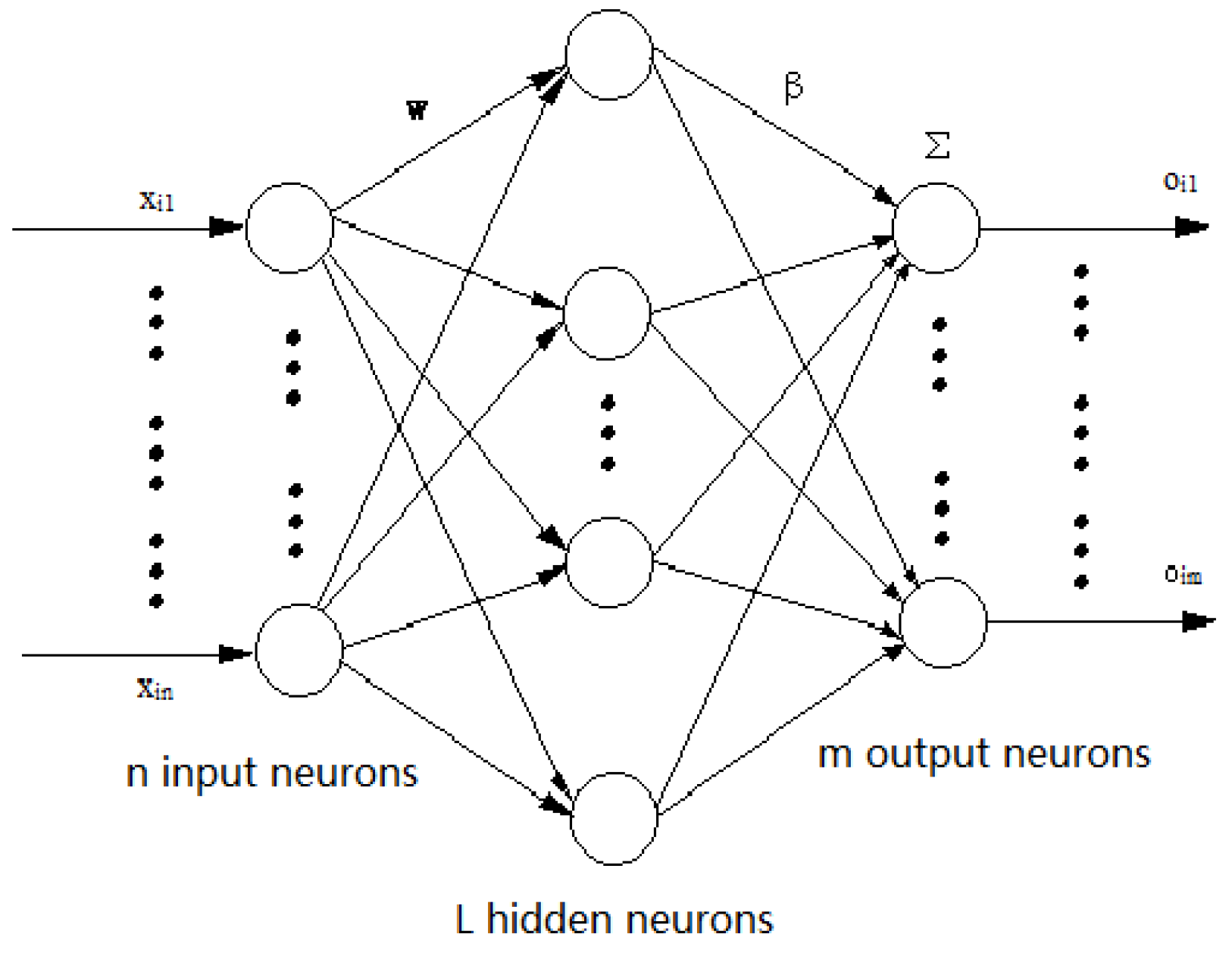
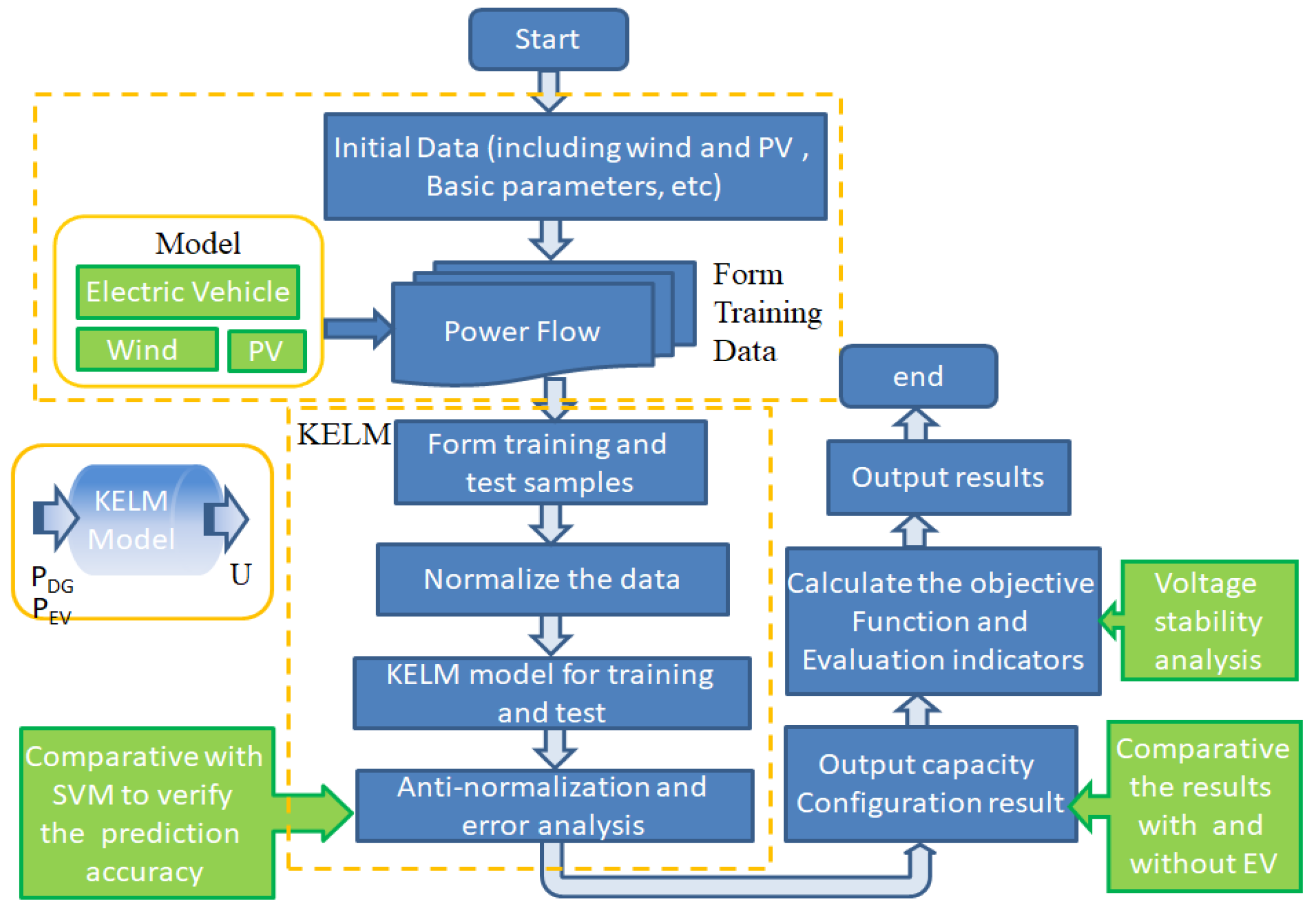
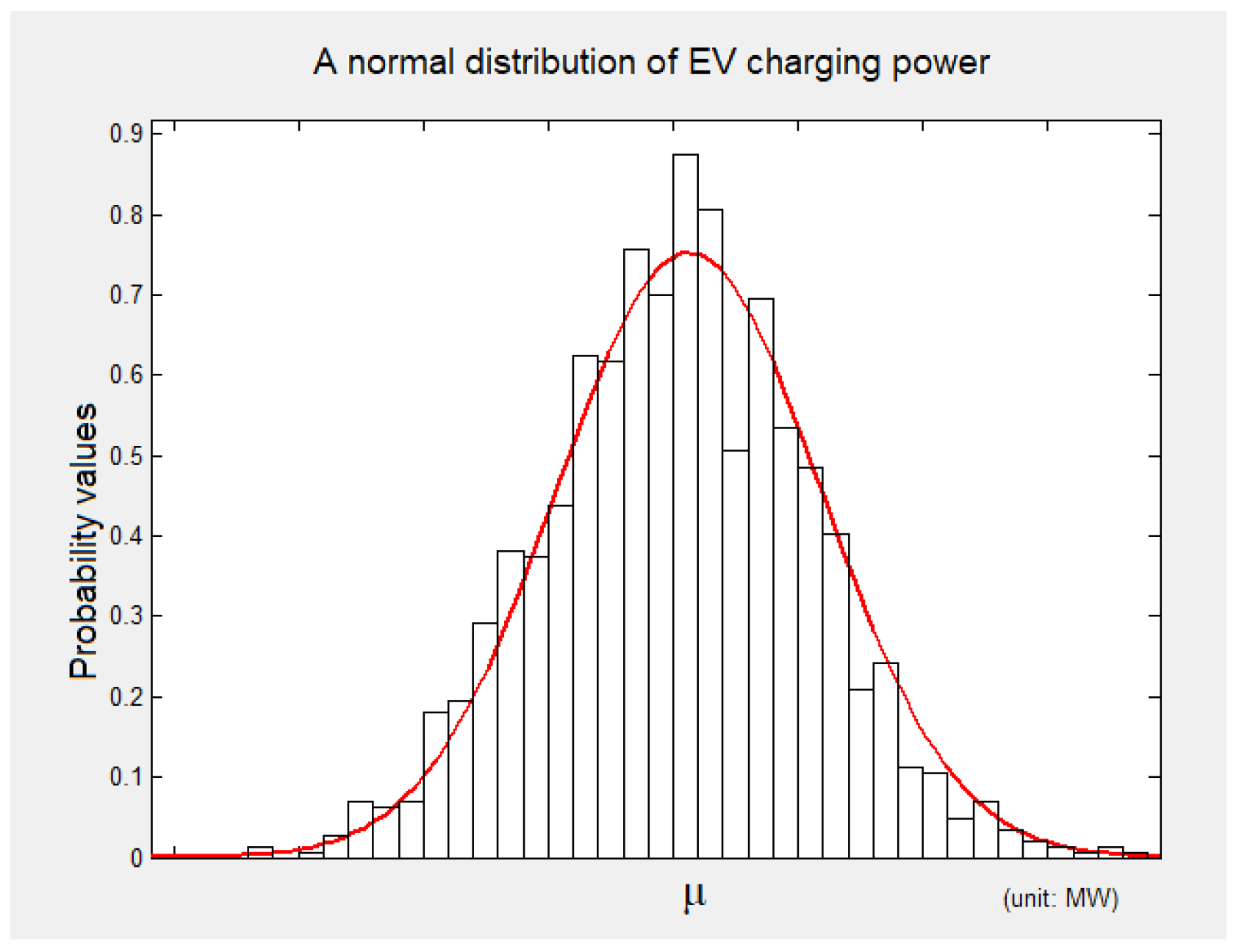
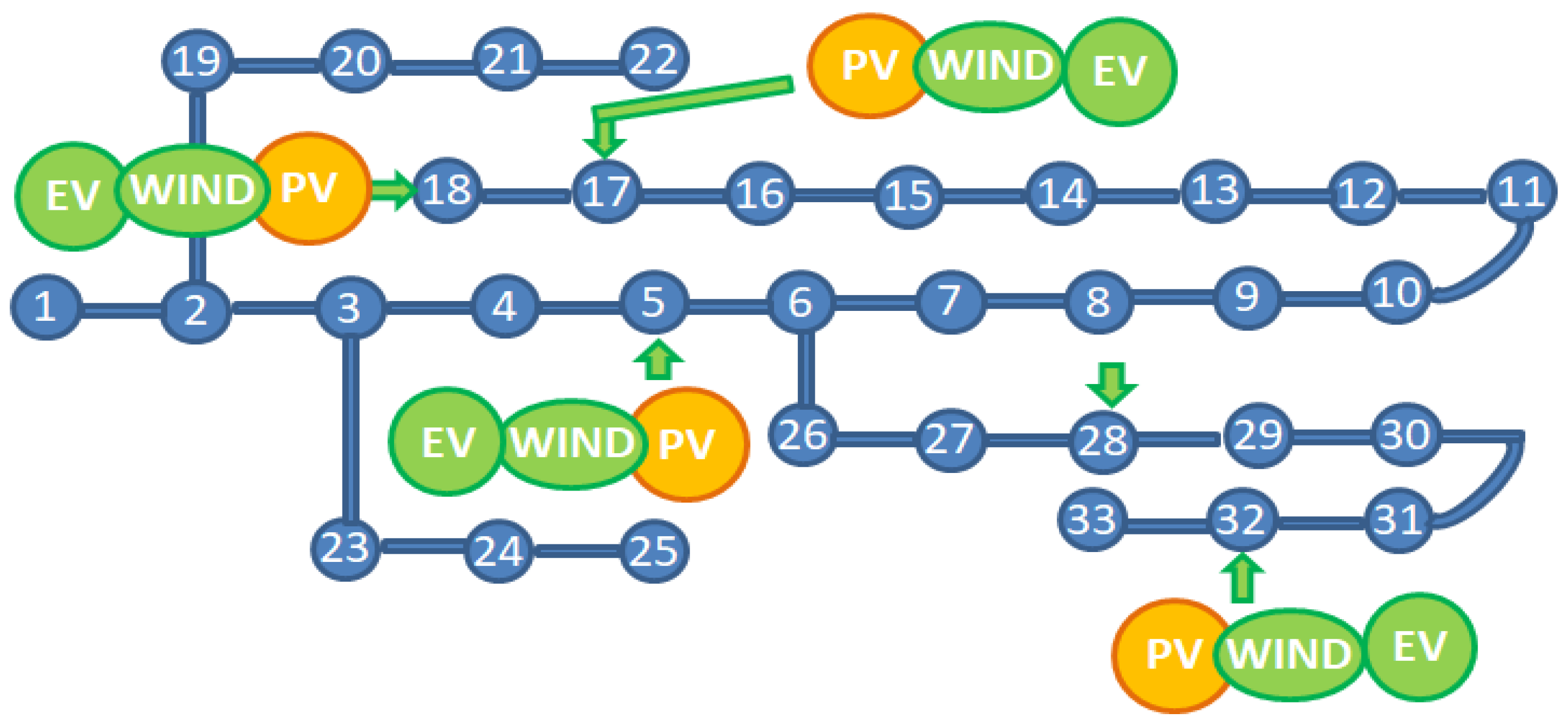
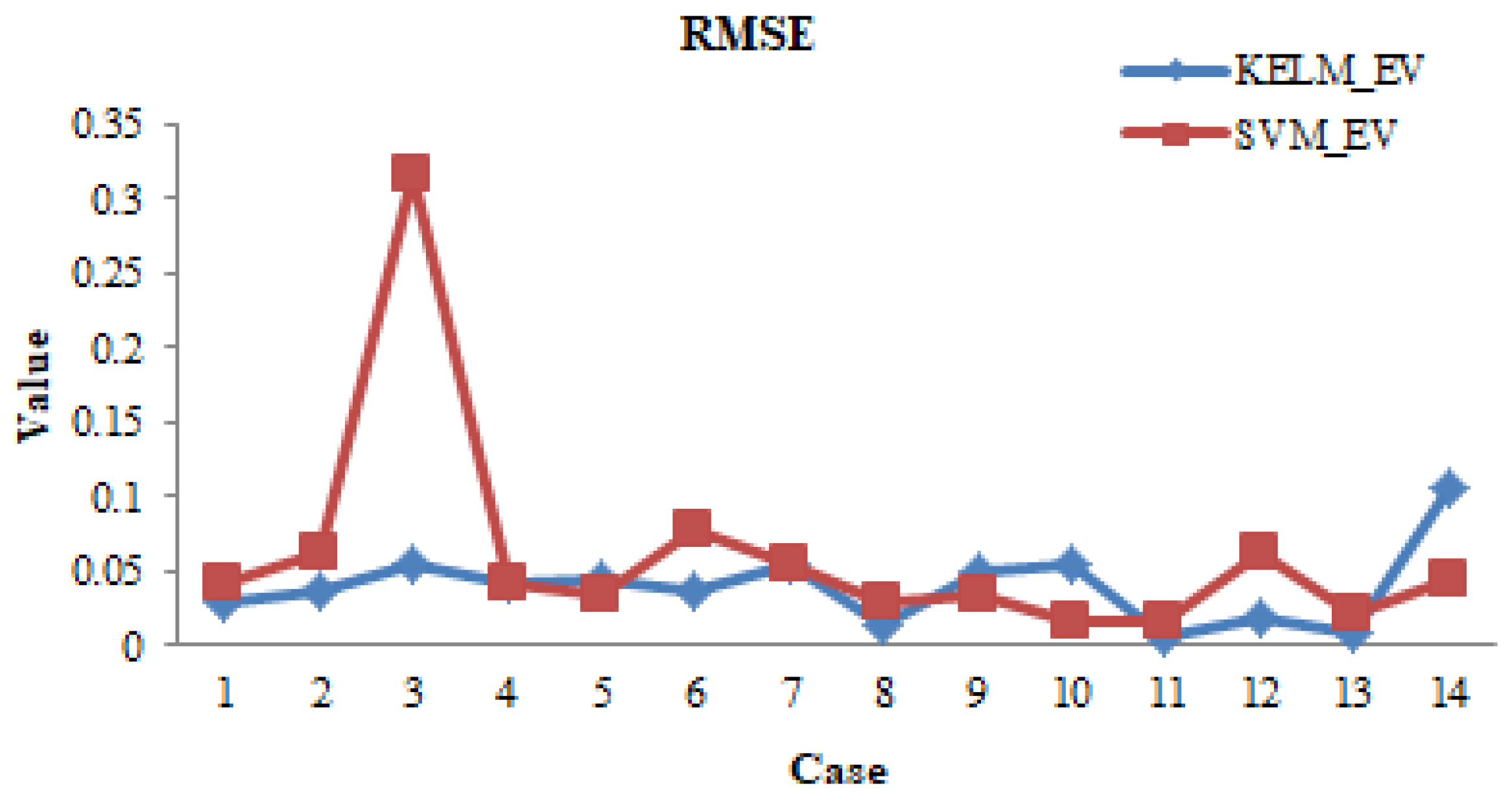

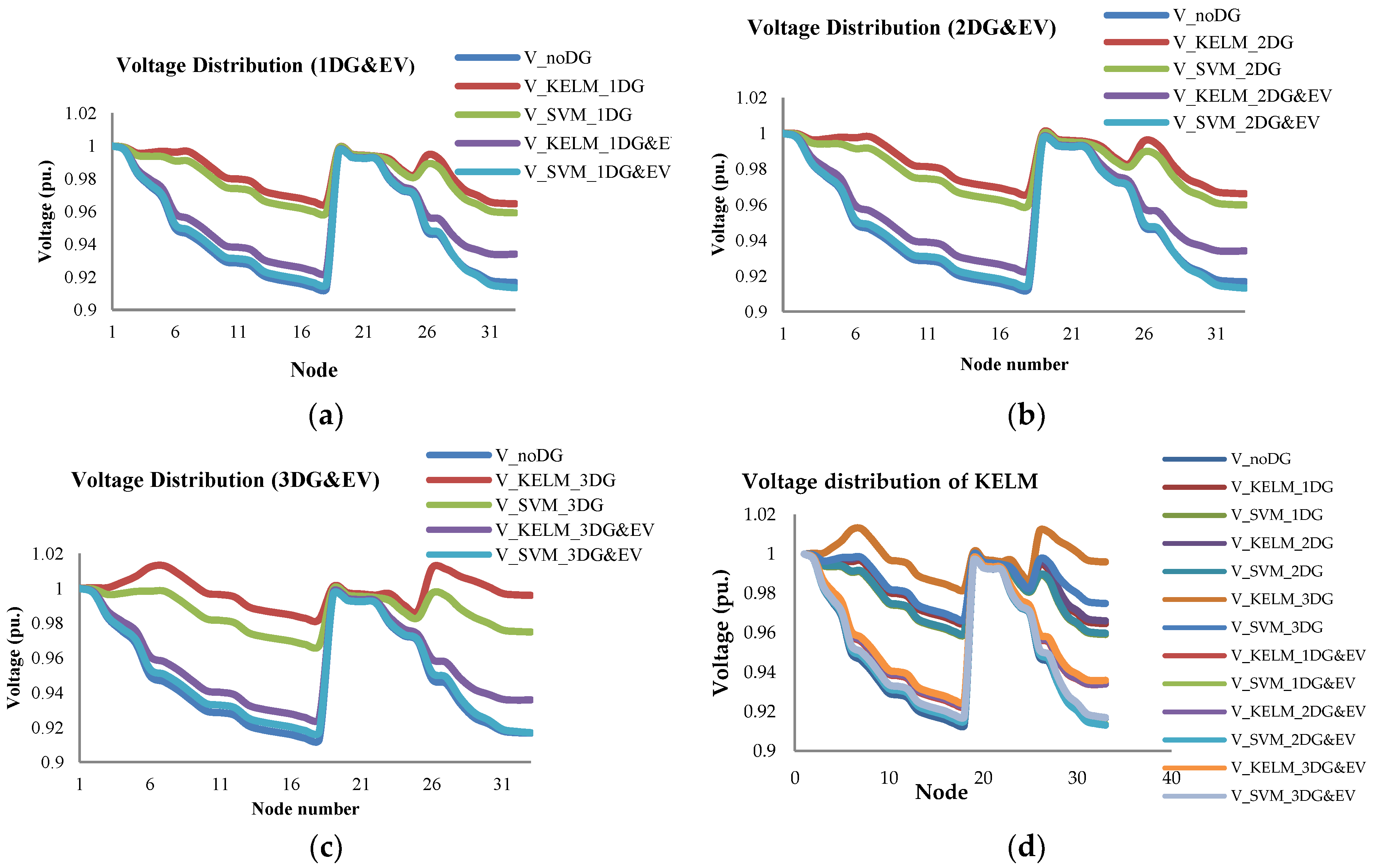
| DG Access Mode | Active Power Loss (kW) | Total Cost (Million RMB) | DG Capacity (MW) | |
|---|---|---|---|---|
| Case 1(Wind) | 107.59 | 2274.74 | 2.87(5) | |
| Case 2(Wind, 1 PV) | 108.22 | 2792.85 | 2.96(5); 0.53(18) | |
| Case 3(Wind, 2 PV) | 108.61 | 3228.59 | 2.96(5); 0.55(18); 0.54(32) | |
| DG Access Mode | Active Power Loss (kW) | Total Cost (Million RMB) | DG Capacity (MW) |
|---|---|---|---|
| Case 1(Wind) | 150.69 | 2699.3 | 3.41(5) |
| Case 2(Wind, 1 PV) | 146.73 | 3623.1 | 3.5(5); 1.03(18) |
| Case 3(Wind, 2 PV) | 140.33 | 4525.7 | 3.47(5); 1.02(18); 1.18(32) |
| Node Number | Ivse_o | Ivse _case1 | Ivse_case2 | Ivse_case3 |
|---|---|---|---|---|
| Node 5 | 0.06707 | 0.06392 | 0.06374 | 0.06294 |
| Node 17 | 0.001802 | 0.001635 | 0.001629 | 0.001604 |
| Node 27 | 0.0543 | 0.0498 | 0.0496 | 0.0486 |
| Node Number | Ivse_o | Ivse _case1&ev | Ivse_case2&ev | Ivse_case3&ev |
|---|---|---|---|---|
| Node 5 | 0.06707 | 0.06588 | 0.06578 | 0.0648 |
| Node 17 | 0.001802 | 0.001764 | 0.001761 | 0.001684 |
| Node 27 | 0.0543 | 0.05297 | 0.05291 | 0.05165 |
| Methods | Method | DG Access Number | DG Capacity (MW) | Active Power Loss (kW) |
|---|---|---|---|---|
| Basic load | - | - | - | 202.45 |
| Reference [23] | PSO | 1 | 3.62 | 131.85 |
| - | SVM | 2 | 3.37 | 200.72 |
| 1.09 | ||||
| Reference [24] | GA | 3 | 1.5 | 106.3 |
| 0.43 | ||||
| 1.07 | ||||
| Proposed | KELM | 1 | 3.87 | 108.6 |
| 2 | 3.26 | 107.2 | ||
| 1.53 | ||||
| 3 | 2.97 | 105.6 | ||
| 0.55 | ||||
| 0.54 |
© 2019 by the authors. Licensee MDPI, Basel, Switzerland. This article is an open access article distributed under the terms and conditions of the Creative Commons Attribution (CC BY) license (http://creativecommons.org/licenses/by/4.0/).
Share and Cite
Yin, Z.; Tu, J.; Xu, Y. Development of a Kernel Extreme Learning Machine Model for Capacity Selection of Distributed Generation Considering the Characteristics of Electric Vehicles. Appl. Sci. 2019, 9, 2401. https://doi.org/10.3390/app9122401
Yin Z, Tu J, Xu Y. Development of a Kernel Extreme Learning Machine Model for Capacity Selection of Distributed Generation Considering the Characteristics of Electric Vehicles. Applied Sciences. 2019; 9(12):2401. https://doi.org/10.3390/app9122401
Chicago/Turabian StyleYin, Zhongdong, Jingjing Tu, and Yonghai Xu. 2019. "Development of a Kernel Extreme Learning Machine Model for Capacity Selection of Distributed Generation Considering the Characteristics of Electric Vehicles" Applied Sciences 9, no. 12: 2401. https://doi.org/10.3390/app9122401
APA StyleYin, Z., Tu, J., & Xu, Y. (2019). Development of a Kernel Extreme Learning Machine Model for Capacity Selection of Distributed Generation Considering the Characteristics of Electric Vehicles. Applied Sciences, 9(12), 2401. https://doi.org/10.3390/app9122401





